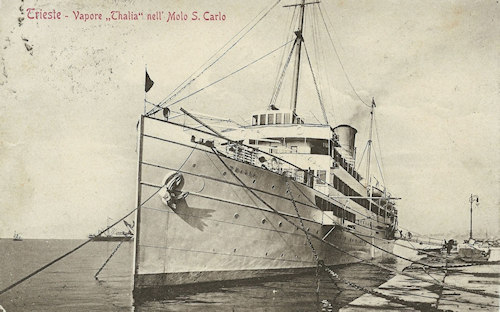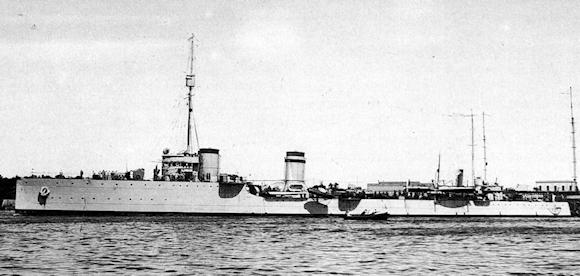This story began on the Galician fronts and continued in the prison camps of Austria-Hungary which, according to Treaty of Versailles, became the responsibility of the Italian Army.
During the attack on Austria-Hungary, Italian troops captured many Russian citizens: already taken prisoner by the Austrians in Galicia they were used as workers in the rear of the Italian front.
These prisoners of war were then collected on the island of Asinara and remained there for two years, since the Italian government did not know who to give them to: the red or to Bianchi (to the new Soviet government or to Denikin's formations, which had remained faithful to the Emperor).
This affair ended in 1920 in Odessa. On February 6, 1920 the "whites" lost Odessa, and at the end of March Novorossiysk.
The Socialist Party of Italy intervened in the case, creating the "Committee for the repatriation of Russian prisoners", which convinced the government to send them to Odessa, occupied by the Soviets, in exchange for the return home of Italian citizens.
 In mid-July 1920, all the Russian prisoners from Asinara left on three steamers on Pietro Calvi, Melpomene and Thalia (photo). On July 19, in the Bosphorus, they were taken under the protection of the Carlo Alberto Racchia. Arriving near Odessa on 22 July. An Italian trade delegation also arrived together with the prisoners.
In mid-July 1920, all the Russian prisoners from Asinara left on three steamers on Pietro Calvi, Melpomene and Thalia (photo). On July 19, in the Bosphorus, they were taken under the protection of the Carlo Alberto Racchia. Arriving near Odessa on 22 July. An Italian trade delegation also arrived together with the prisoners.
At 6 o'clock in the evening the three steamers approached the Platonovsky pier. The explorer Rashia which had accompanied the steamers with the prisoners along the way, almost reaching Odessa, it hit a mine and sank. Of the crew, 5 men died and 20 were injured (from the "Morjak" newspaper of 26.07.1920).
There is another version of the facts, also based on the press of the time: "on the evening of July 22nd, at the Platonovsky pier, three Italian steamers approached one after the other on Melpomene, Talia and Pietro Calvi, which carried around 4500 prisoners of war and 50 immigrants. However, the event, already familiar to the inhabitants of Odessa, has gained wide international resonance. Abeam the Bolšoj Fontan lighthouse was blown up by a mine and the Italian explorer sank Carlo Alberto Racchia, which accompanied transport boats with prisoners of war. Odessa fishermen actively participated in the rescue of the sailors. 9 Italian sailors died, including 5 stokers, who were in the engine compartment and 20 were injured." (Monahov, Stepanenko 2008. page 43).
The bodies of the Italians were taken to Odessa and the city arranged for their burial, after asking the commander of the squadron to send troops of sailors to pay the last honors. All of Odessa experienced the event. Together with the Italian command it was decided to bury the Italian sailors on the Kulikovo field with all honors. The funeral took place on July 24th around 5pm.

From the Platonovsky pier, the port workers with the orchestra and the crews of all three Italian transport boats, with crowns and red flags, headed towards Valihovsky alley, where at that moment military units, representatives of the organizations of the workers, the Soviet authority and the political parties. Two wooden coffins with the bodies of sailors Vincenzo Re (photo) and Domenico Pellegrino, covered with Italian flags, were placed in the chapel. In the funeral procession behind the coffins paraded the sailors, the representatives of the Army general staff, the "gubrevkom" (provincial revolutionary committee) and the Italian socialists. A cannon salvo from the ships followed, and a rifle volley on the Kulikovo field joined in.
Only in 1926 were the bodies of the Italian sailors exhumed and reburied in their homeland.
Almost immediately after the sinking the Italians attempted to negotiate with the Bolsheviks for the recovery of the Racchia and the destroyer Alessandro Poerio he was ready for recovery. But a few months later the Bolsheviks announced that the recovery of the ship would take place at their own expense. However, according to Soviet data, as late as August 9, 1920 the commander of the naval forces of the Republic AV Nemitts telegraphed to Moscow: “communicate to the Italian admiral Degrassi that the destroyer Racchia has exploded in a minefield area, therefore the approach to it is not possible until the end of the Civil War” (Lukin 1925. - page 335).
It is known that at the end of 1920 the EPRON ("special purpose underwater work expedition") tried to raise the Racchia on the surface, but the destroyer turned out to be destroyed in three sections and its restoration would have cost more than the construction of a new ship. In 1930 the armament was removed from the explorer and installed on the training ship Amur, moored near one of Leningrad's riversides. (Корабли 1981 - page 56).
After almost half a century of oblivion, the remains of the Carlo Alberto Racchia they were rediscovered and identified in 1977 by divers from the Sadko in Nikolaevsk. Divers from various organizations later visited the site of the sinking. Divers from the Prikordonnik association conducted more detailed studies from 2007 to 2015, during which measurements and photographs were taken.
The ship Carlo Alberto Racchia, named in honor of the politician, senator and minister of the Navy CA Racchia (1833-1896), was the twin of the type explorers Carlo Mirabello. Built in 1914-1916 at the Ansaldo shipyard in Sestri Ponente, it actively participated in operations in the Adriatic in the First World War.
On 20 March 1920 he left Taranto to move to Constantinople under the command of the naval division of the Levant, where he was assigned to patrol the Bosphorus and the Black Sea.
REFERENCES
1) Igor Sapozhnikov – The return to his homeland in 1920, the fate of the Russian prisoners of Asinara and the loss of the Italian explorer Racchia - Odessa 2016
2) L. Bigi - A life in the Navy - From the first to the second post war. - Milan: Fondazione Italo Zetti, 2003. - 347p
3) Materials of the II international scientific-practical conference, dedicated to the 95th anniversary of the State Archives of the Odessa region (1920-2015) (Odessa, 3-4 September 2015) Series: "The works of the State Archives of Odessa region"
4) F. Favre - The Navy in the Great War. Air, naval, underwater and land operations in the Adriatic - Gaspari Editore, 2008.
5) Historical Office of the Navy - Explorers, frigates, corvettes and Italian notices - Rome 1969. (This volume reports that 9 sailors died and 9 others were injured)
Photo: Bagnasco collection taken from volume 13 Navigator class destroyers by M. Brescia / Sergio Sergas collection / web












